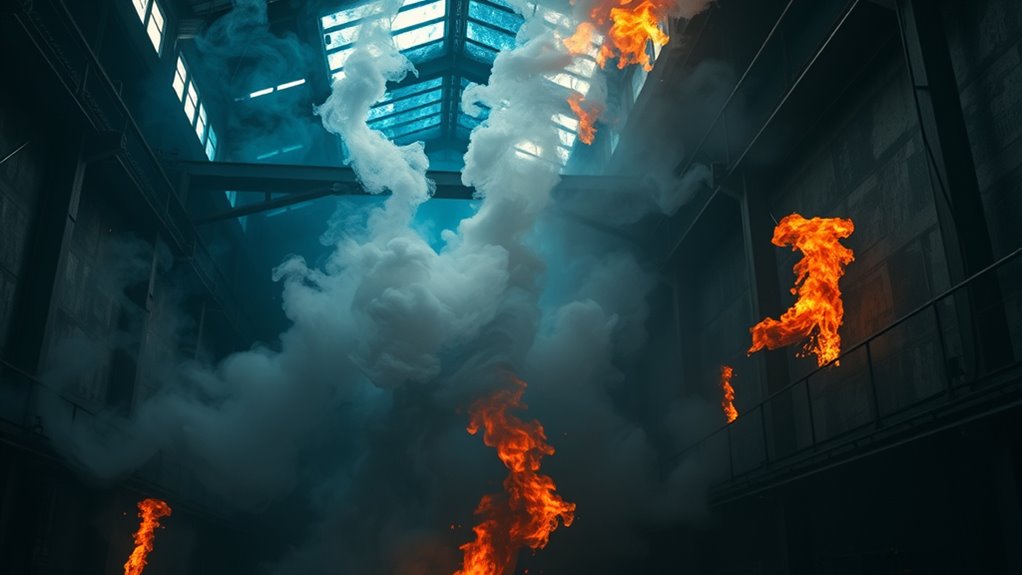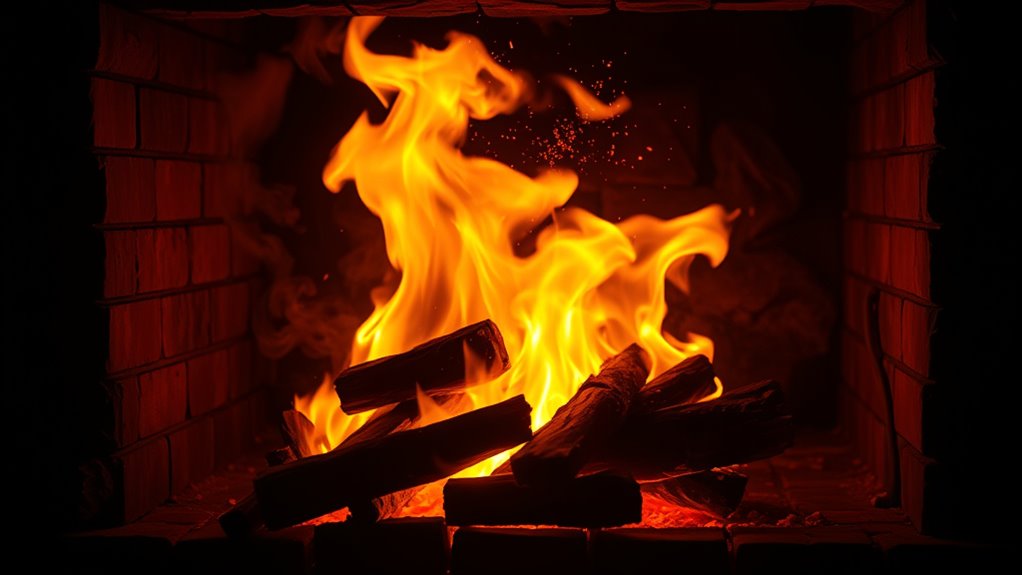In fire-building physics, understanding airflow tricks helps you control flames in any setting. By manipulating ventilation—like opening or closing doors and windows—you influence oxygen supply and hot gas movement, which can either feed or suppress the fire. Smart control of airflow allows you to keep flames alive or extinguish them quickly. Mastering these techniques means you can improve safety and efficiency. Stick with us, and you’ll discover more about controlling fire behavior through airflow mastery.
Key Takeaways
- Proper airflow can supply oxygen to sustain or intensify flames, even in adverse conditions.
- Ventilation paths and window placements influence fire growth by controlling oxygen flow.
- Manipulating hot gases and smoke movement affects the fire’s intensity and spread.
- Strategic ventilation can create pressure differentials that either feed or suppress flames.
- Understanding airflow physics allows for effective fire control and building safety measures.

Have you ever wondered what happens inside a building during a fire? It’s a complex dance of physics, where airflow plays a pivotal role in determining how the fire develops and how it can be controlled. One key aspect is ventilation strategies, which are intentionally designed or naturally occurring airflow paths that influence the fire’s behavior. Proper ventilation can either feed the flames or help suppress them, depending on how it’s managed. When ventilation is aligned with fire suppression efforts, it can markedly improve the fire’s combustion efficiency—the rate at which fuel converts to heat and gases. By understanding and manipulating airflow, firefighters and building designers can influence the fire’s growth, intensity, and spread.
Inside a burning building, hot gases and smoke rise rapidly due to buoyancy, creating a pressure differential that draws in fresh air. If the ventilation openings are strategically placed, they can optimize airflow to sustain the fire’s combustion efficiency. For example, large exhaust vents at the top of a structure allow hot gases to escape, reducing the buildup of heat and smoke, which in turn can slow the fire’s spread. Conversely, opening windows or doors on the windward side might introduce more oxygen, intensifying the flames. That’s why ventilation strategies are often a delicate balance—too much fresh air can feed the fire, while insufficient airflow can smother it. Skilled fire professionals understand how to manipulate these airflow patterns to control or extinguish flames effectively.
Strategic ventilation balances airflow to control fire growth and safety effectively.
In terms of combustion efficiency, airflow impacts how completely the fuel burns. When a fire receives the right amount of oxygen through well-planned ventilation, it burns hotter and more efficiently, producing less smoke and fewer toxic gases. This is especially critical in firefighting tactics, where controlling airflow can mean the difference between a fire that rapidly becomes unmanageable and one that can be contained more easily. Building design also employs these principles to improve safety during fires—ventilation systems can be configured to either limit oxygen supply or facilitate smoke extraction, directly affecting the fire’s intensity and progression. Additionally, understanding the contrast ratio in fire dynamics can help predict how well a fire will be contained under varying conditions.
Understanding the physics of airflow and ventilation strategies doesn’t just help in fighting fires; it influences how buildings are constructed and equipped to handle emergencies. Properly designed ventilation controls can enhance combustion efficiency, making fires easier to manage and less destructive. When you grasp how airflow interacts with fire, you gain insight into the essential tricks that keep flames alive—or snuff them out—in any conditions. It’s a critical aspect of fire-building physics that combines science with practical application, ultimately saving lives and property.
Frequently Asked Questions
How Do Different Weather Conditions Affect Airflow in Fires?
Weather conditions considerably impact airflow in fires. Wind influence can intensify flames by feeding oxygen and creating turbulent airflow, making fires spread faster. Humidity effects, on the other hand, can dampen flames, reducing their intensity; high humidity absorbs heat, slowing combustion. You’ll notice that on windy days, fires become more aggressive, while in humid conditions, they tend to weaken. Understanding these factors helps you predict fire behavior more accurately.
Can Airflow Manipulation Extend Fire Safety in Buildings?
You can definitely enhance fire safety in buildings through airflow manipulation. By implementing effective ventilation strategies, you control how air moves, limiting the spread of smoke and flames. Airflow optimization helps maintain safe conditions, allowing for better evacuation and reducing damage. Smart design choices, like strategically placed vents and exhausts, ensure proper airflow, boosting safety and making fire management more effective in various scenarios.
What Materials Best Enhance Airflow for Fire Stability?
You should focus on materials like fire-resistant barriers and advanced venting systems to enhance airflow for fire stability. Fire-resistant barriers prevent flames from spreading while allowing controlled airflow, maintaining combustion. Venting systems help direct airflow efficiently, ensuring the fire gets enough oxygen without risking uncontrollable spread. Combining these materials creates a balanced environment where flames stay alive but are contained, improving overall safety and fire management in buildings.
How Do Firefighters Control Airflow During Active Fires?
Imagine you’re battling a wildfire; you control airflow by adjusting ventilation strategies. You open or close vents to direct oxygen, helping flames intensify or die down. For smoke control, you create barriers or use fans to redirect smoke away from escape routes. This hands-on approach allows you to manage fire behavior effectively, ensuring safety and stability during active fires. Proper airflow control is vital in firefighting operations.
Are There Innovative Technologies Improving Airflow Management in Fires?
You’ll find that innovative ventilation systems and advanced smoke control technologies are transforming airflow management during fires. These systems actively direct fresh air to fuel the fire while extracting smoke and heat, improving safety and visibility. Smart sensors and automated controls optimize airflow in real-time, adapting to fire conditions. This clever use of ventilation and smoke control enhances firefighting effectiveness, helping to contain fires faster and protect both responders and occupants.
Conclusion
You might think maintaining a fire in tough conditions is impossible, but understanding airflow tricks proves otherwise. By leveraging chimney effects, proper vent placement, and controlling drafts, you can keep flames burning strong regardless of weather. Don’t let wind or dampness fool you — with these physics principles, you’ll master fire management and stay warm, safe, and confident in any environment. Trust the science, and watch your fire thrive against all odds.










